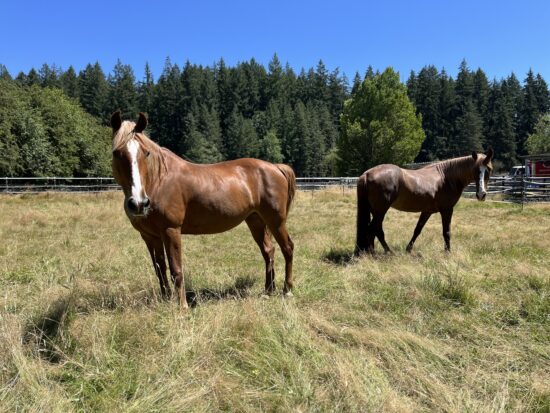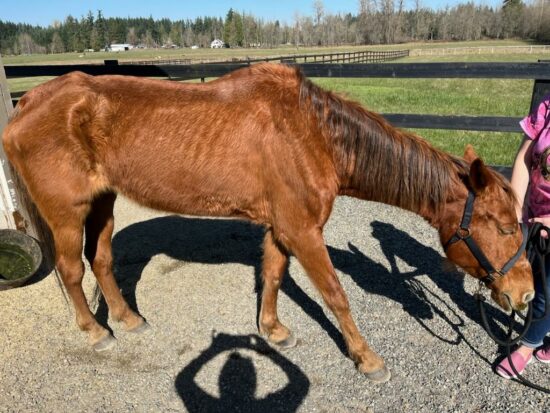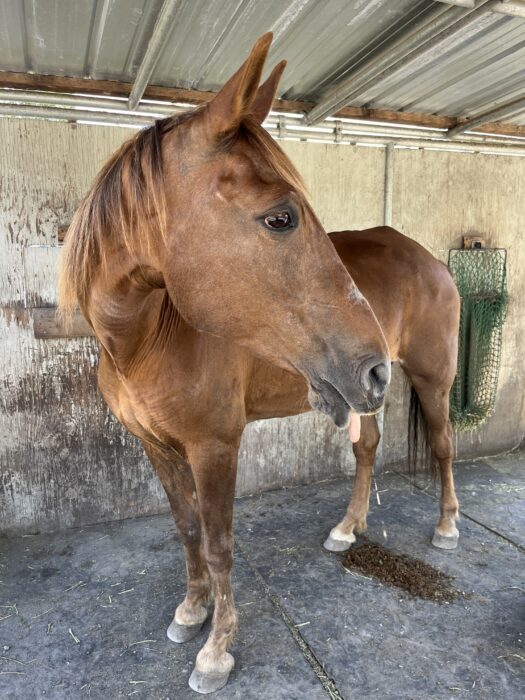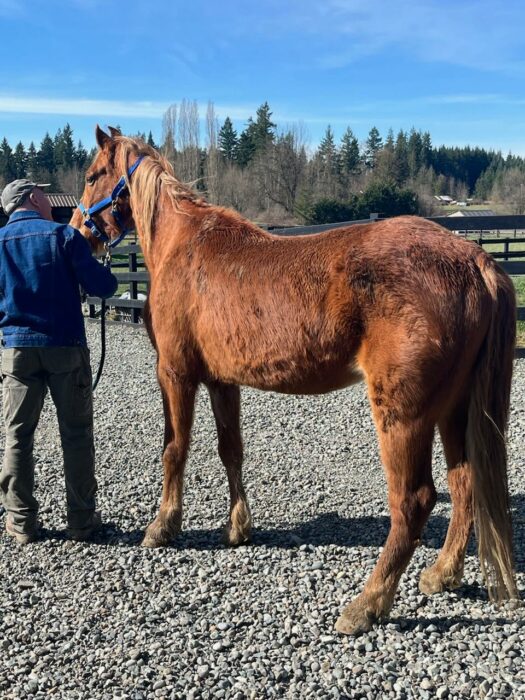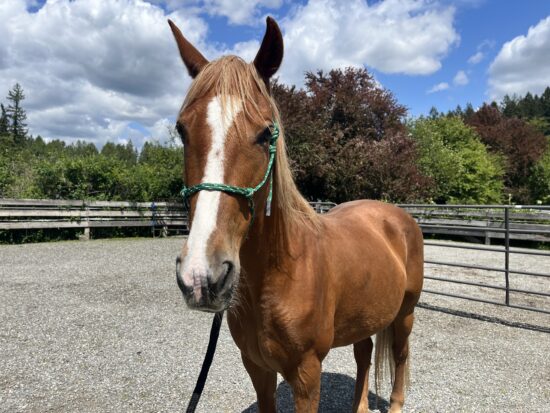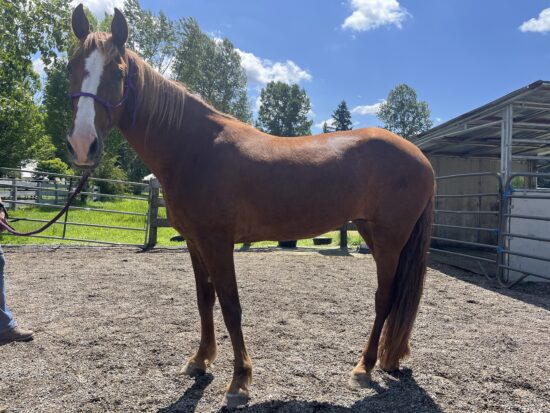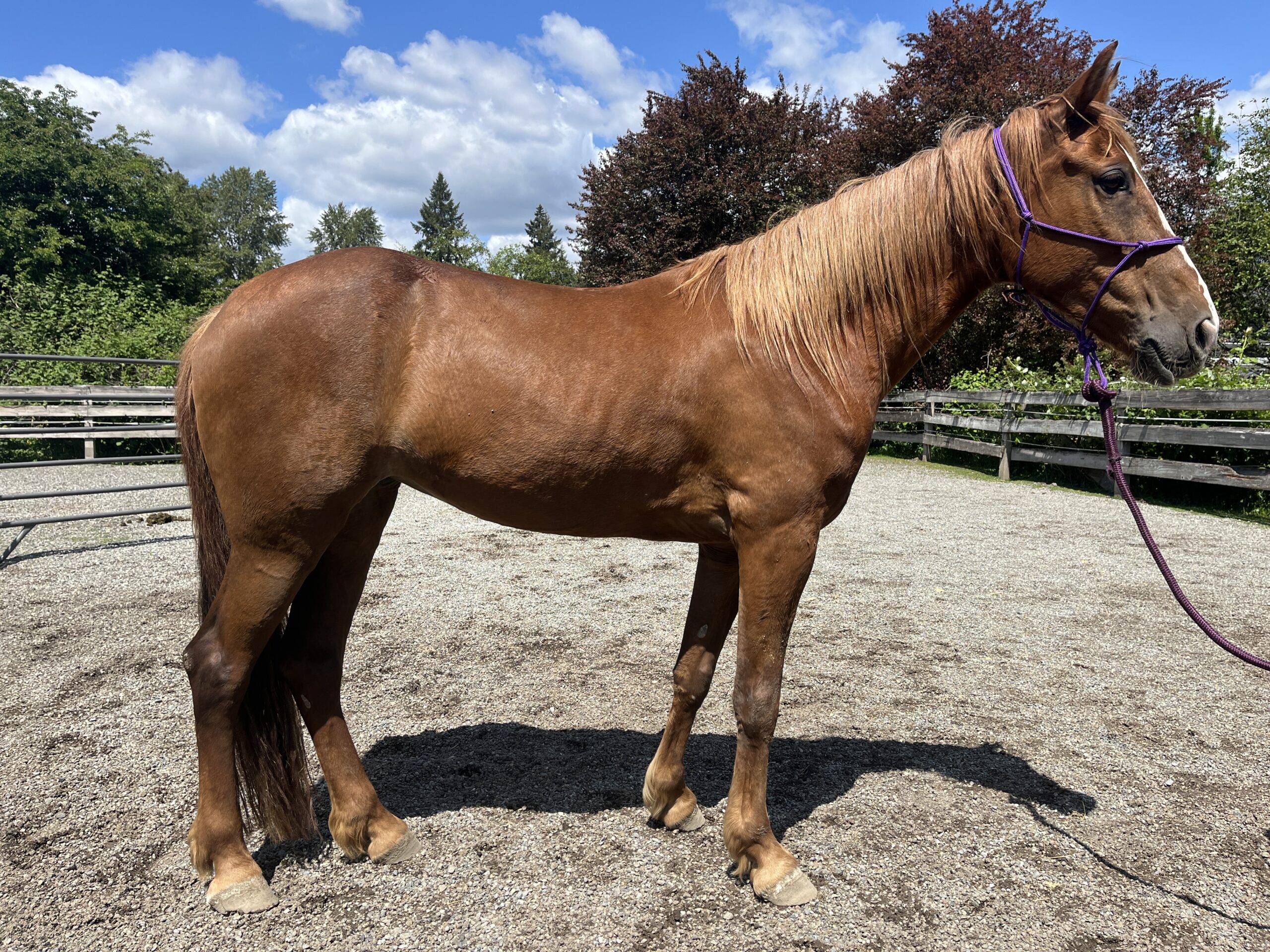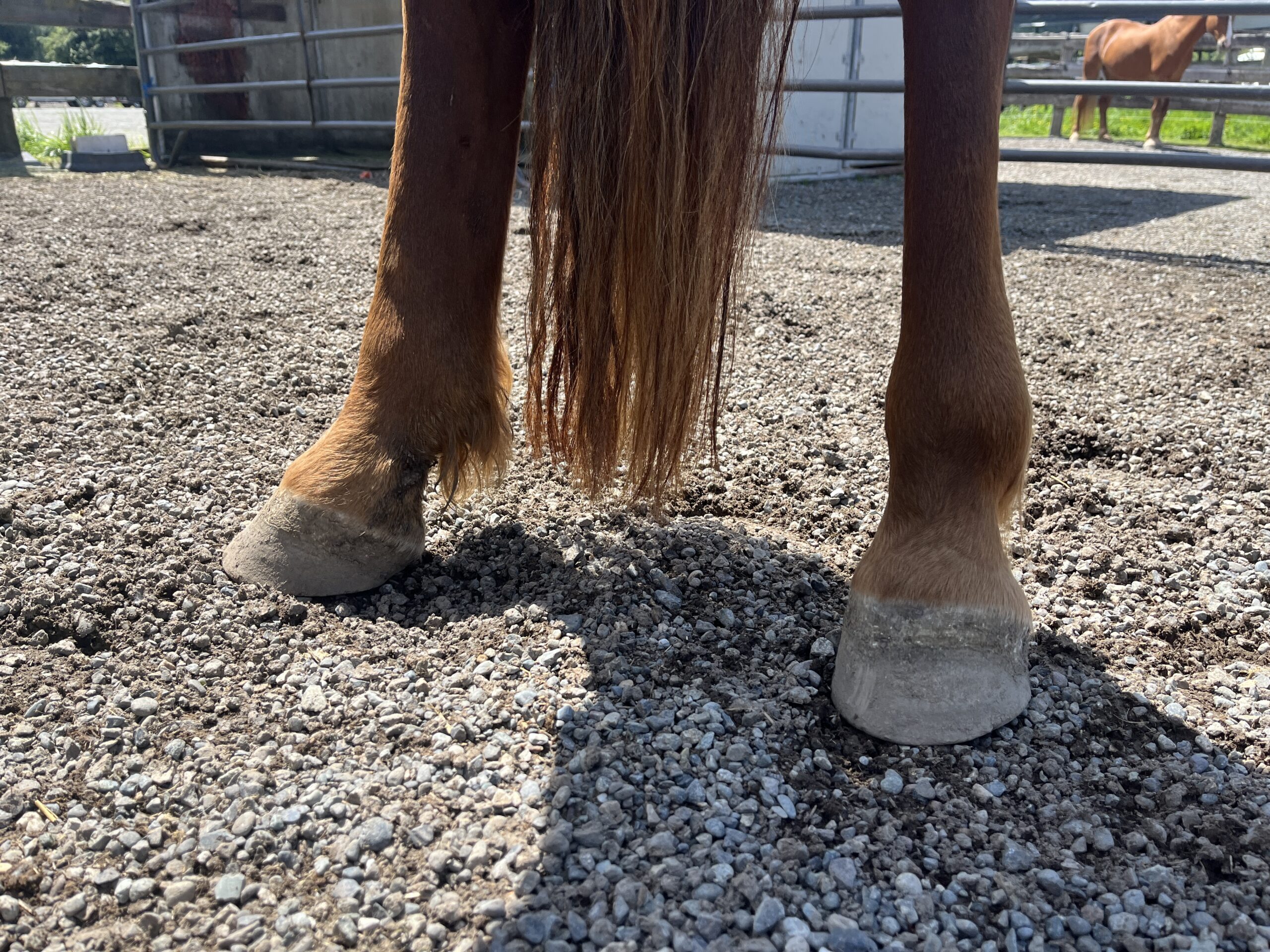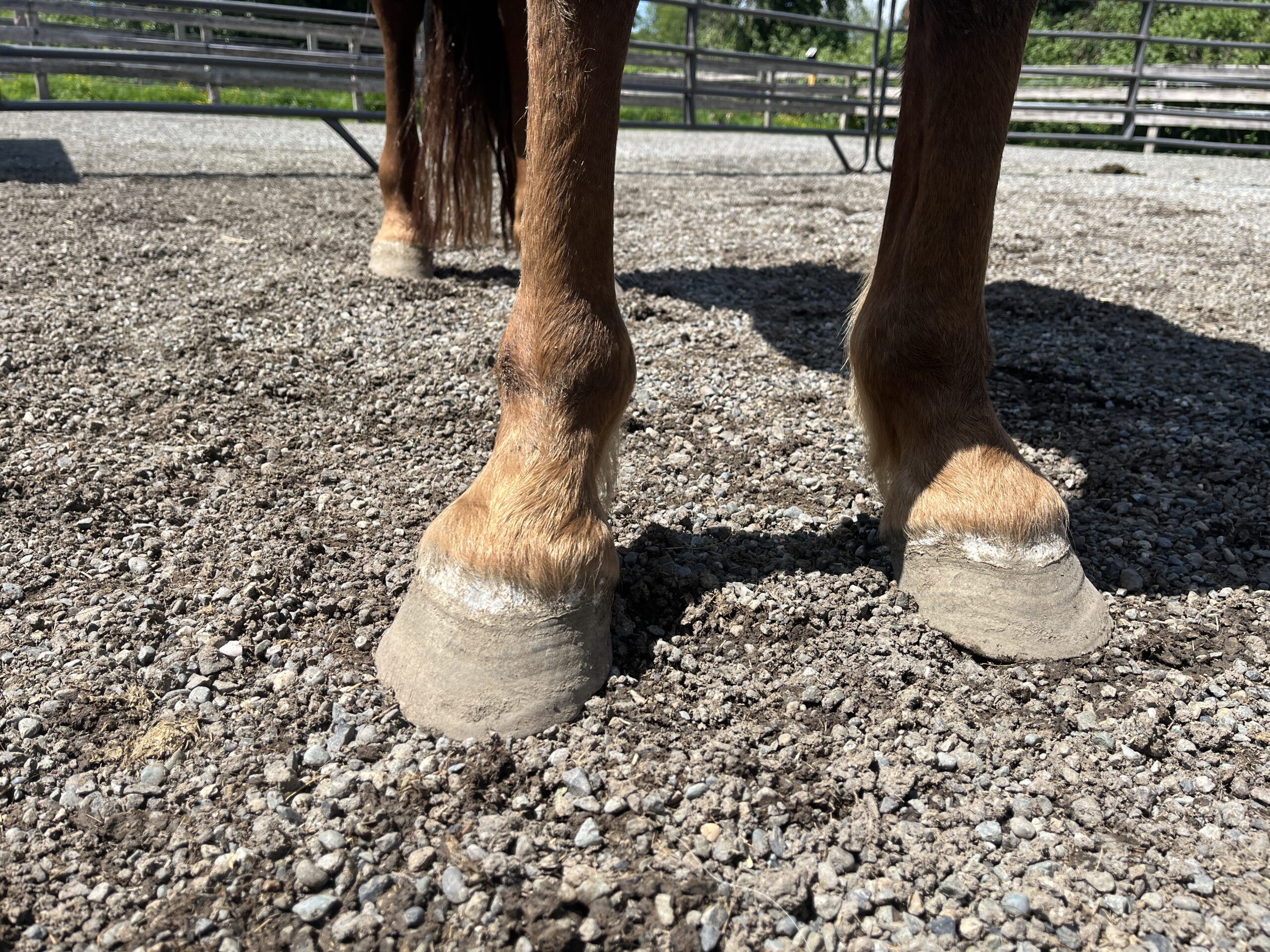Deja Vu
2009 Tennessee Walking Horse Mare
Suitability: Companion, For Intermediate Handler
Color: chestnut
Markings: blaze
Height: 14.2 hh
Weight: 870 lbs
Adoption Fee: $300
Deja Vu was part of a four horse Pierce County Animal Control seizure in early 2024. Deja was very thin, and long overdue for some basic care. Thanks to the work of Pierce County, her foster, and the vets at Tacoma Equine, Deja is looking much improved from the condition she was first seen in. Now at SAFE, Deja is continuing her rehabbing and despite being the most nervous of the bunch, is settling in well.
Deja is a sensitive but smart mare, but she is making big strides in her forward progress. She stands well for the farrier and is gaining more confidence each day! It is unlikely that she was ever ridden in her life, so Deja will be adopted out as a companion, and to the right person she is ready to go to her forever home now.
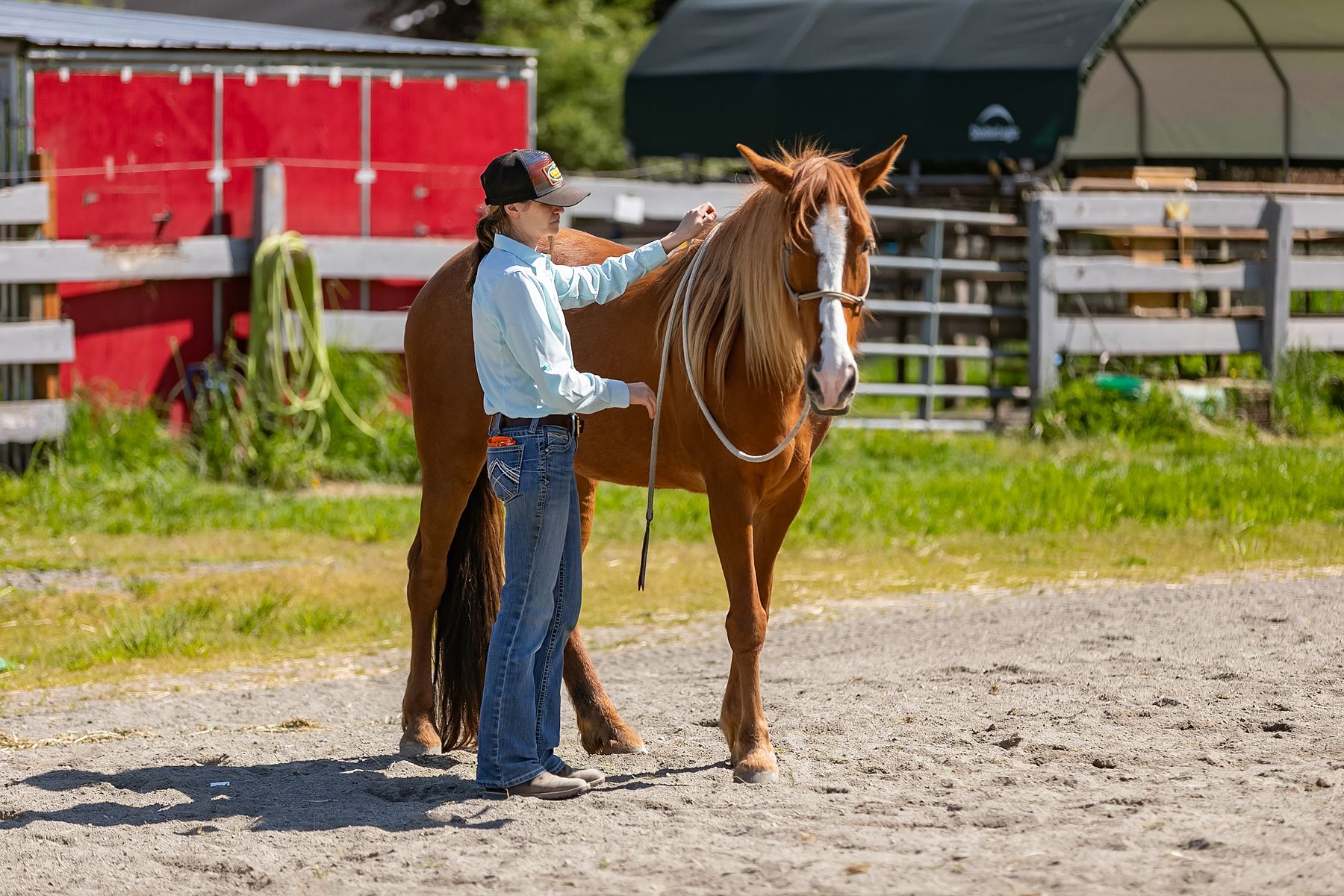
May Joel Conner Clinic Report: Deja Vu
Meghan N worked alongside Deja Vu in the May Joel Conner groundwork Clinic, and has the following to say about her experience:
“Over the past three days, Deja and I had the opportunity to learn and grow together during the Joel Conner Clinic. This mare is incredibly intelligent, but it’s clear she’s experienced some letdowns in the past. Because of that, it’s a bit of a challenge for her to fully let go and trust that she’s safe; but you can just feel how much she wants to place that trust in you.
As a sensitive gal, Deja responds best to gentle yet clear communication, she tries so hard to get it right. Together, we worked on a range of exercises, including walking a unified circle, transitioning smoothly into a fast walk, then a trot, and back down to a walk, all based on feel. Deja has a tendency to worry about her surroundings, but during this clinic, she made significant progress by letting go of those distractions and tuning into my ask. When she did get a little bothered, she was able to come back and reconnect after some hindquarter and frontquarter work; remembering that she can find freedom and confidence in the ability to move her feet.
For much of the clinic, Deja walked with a calm, balanced frame and a relaxed, lowered head on the unified circle; she was truly beginning to find her rhythm. But like any being with a past, there were moments when fear crept in, especially when she felt unsupported or when something moved in her off eye. In those moments, Deja would react rather than respond, trying to get away from whatever felt scary. We worked a lot on changing eyes to remind her that she isn’t stuck, she has options and can move through uncertainty.
Leading up to the clinic, Deja had been introduced to the flag. Initially, it was a major source of fear for her. But now, she’s learning that the flag can be a helpful tool. Today, she’s not only curious about it, she wants to smell it, enjoys being petted with it, and is starting to understand that sometimes the flag carries meaning, and other times it’s just present without any pressure. She is also learning more about backing up, but still needs to work more on shifting her weight to her hind so she is free on her front end and can fully lift and move with ease.
This clinic was an incredible opportunity for growth, for both Deja and me. Watching her confidence build, moment by moment, was a powerful reminder of how much potential she holds when given the right kind of support. I gained valuable insight into the areas where she still needs reassurance, and I feel so honored to be part of her journey.
I’m excited to continue walking alongside this sweet, sensitive mare as she learns to trust more deeply and step fully into her empowered self. With patience, consistency, and a lot of heart, I know she’ll blossom into the happy, confident horse she was always meant to be.”

Adopting a Companion Horse from SAFE
If you look at the current population of horses at SAFE right now, eleven of them are what we call “companions” — older horses that can’t really be ridden anymore…but still need a safe, permanent home. Any of these horses would tell you that caring for a companion will enrich your life in ways you’ve never even thought of! Adopting a senior pet is the ultimate act of love; a clear example of something you do mostly for their sake. In the case of the older SAFE horses, these mares and geldings have survived neglect or abuse, and now they deserve permanent homes where they will be well fed, well cared for, and well loved.
One factor that sometimes holds people back from adopting a senior horse is the cost associated with their care, especially when it comes to the end of their lives. Euthanasia and removal can cost upwards of $1,000 in western Washington, which is a lot to take on. So SAFE would like to offer potential senior horse adopters some assistance with these costs.
If you adopt a companion horse from SAFE, we will sign a contract ensuring you that when the time comes to say goodbye, we will cover the costs of what needs to be done. Your lucky horse will come to you fully rehabilitated and up to date on all routine vet care, with an established feeding plan and an honest behavioral assessment. All we ask in return is that you carry on their good care, and let them know every day that they are home.
Offering this assistance is completely worth it to us, because it means that more of our beloved seniors will be able to enjoy a real home with a person or family that welcomes and values them. And crucially, by adopting one of our senior horses, you will have opened up space at SAFE for another horse to be rescued, a horse who desperately needs our help. We operate under a cap, which means we have to turn horses away when we don’t have space. So adopting a senior horse from us could literally save another horse’s life.
This program is not designed to make horse ownership affordable to anyone who can’t honestly afford it. The adoption will be approved or denied using the same requirements and standards as any horse we adopt out. As an adopter, you will legally own the horse, so you’ll be responsible for the cost of feed, shelter, farrier care, and vet care, for as long as their quality of life remains high.
When the end approaches, you will have our full support: logistical, financial, and even emotional. In the last 20 years, we’ve helped so many horses pass on, so we are well qualified to help you know what signs to watch for, how to make that difficult decision, and how to carry it through with dignity and love.
Adoptable senior horses on the SAFE website that are included in this program will be designated as such. Adopters are not obligated to make use of the monetary help, but we hope that knowing it’s there will make it easier to say yes to a sweet and wonderful senior horse that needs you.

Quirky Deja
Deja is what you might call, in layman’s terms, a silly goose. When she is in her space with her friend-sister-mother Cleopatra, aka, comfortable, she is a mellow sight — a mare who can nap for hours in the sunshine and who enjoys mutual grooming. But once removed from this bubble, she is on alert. Her eyes grow large, her ears prick forward, she looks for things to worry over. It is possible to support her in these times, yes, and it grows a bit easier with each outing, but she takes a lot of reassuring to get ‘with you,’ and even then can be easily persuaded back into a state of high alarm.
Last week, in preparation for our new arrivals, we had to do some paddock re-configuring, a game of musical chairs we play every so often, with the only difference being no one is left unhoused once the music stops. This meant moving Cleo and Deja to another paddock, one that just so happened to be on the other side of the property. Now, these mares had spent time around the barn, coming into the arenas to be worked and such, but at the end of it all they always returned to ‘paddock 3.’ Deja, in her new space, ‘paddock 20,’ made it very clear to us that she was a west side girl at heart, and demanded loudly and constantly that she be returned to her original lodgings. Even an alfalfa snack and a sweet water would not placate her for long — she stood stubbornly at the bottom corner of the fenceline and called, not for her friend who was standing nearby (also contributing her voice to the protest), but to the paddock she had come to know and love, apparently. Like we said earlier, silly goose. Once the mares returned to the side of the property they had come to know, they immediately relaxed. Sometimes you have to pick your battles, and this space-boundness was one for another day.
Despite her silly quirks, Deja is a cool horse, and it is extremely gratifying to watch her grow a little more comfortable in her own skin with each working session: the way she drops her head down low to explore the space closer to the ground, the way her walk lengthens. The flapping of a flag no longer bothers her as it once did, and her skin no longer clenches and coils at its touch — at least, not to the same degree. Once nicknamed ‘dozer’ for her propensity to bowl you over in her pursuit of being where she wanted, she will now lead with feel. This is a special, unique girl, that’s for sure!

J’aime bien, Deja Vu
Deja Vu is ‘seen before’ in French, that sensation of having experienced an event, even if it is completely novel. But working with this mare is entirely unique each time, no sense of a ‘been there, done that.’ Well, some sense of having been there, since we do not start at ground zero each time we begin a session, rather we build on the foundation we have been working hard at creating.
When Deja first arrived at SAFE, she was reluctant to be caught, and absolutely petrified of the flag. Even keeping it at a distance and waving it as quiet as possible saw Deja pulling at the end of her line, desperate to get away. Petting her with it was also an absolute no go, a concept that was very difficult for her to consider. But Deja has come a very long way from those first days here, and it has been truly amazing getting to watch her grow in her confidence and, as a result, let down in her physicality.
Deja is a very intelligent horse who picks up on things very quickly, and it has been neat to observe how much she holds on to from previous sessions. Each time I pull her out, she starts a little further than she did the previous day. It’s been great watching her progress in such broad strokes. As of late, we have been closing in the boundaries a bit more to challenge her, and she has been taking it in stride. While the flag is not the great villain it once was, she still does not care for it on her neck or above her withers. Fair enough, as these are blind spots. But in getting in and getting out, she is learning that she can move her feet away from the thing that makes her nervous, and that it is not going to bite her. Quite the opposite actually, for flag pets must feel rather nice. Deja has reached a point of understanding with the flag where she wants to stop with it petting her — a previously unheard of concept. There are more than a few moments in there where I have to ask her to move, because she is content to let it rest upon her. Content is truly the word here, because there is no longer the bracing fear, deer-in-the-headlights kind of scenario when it touches her. Or at least, not nearly as much.
She is learning to move away with more balance and intention, and you can see it in the set of her head as she walks around in a circle. Just because she is a Tennessee Walker does not mean her ears have to live in the clouds. It has been nice to watch her mellow out and literally let down.
One thing we are still working on is the separation of her and her best friend (and potential mother?) Cleopatra. Having lived together all their lives, these two are understandably bothered when separated from one another, but they are both learning to find peace and security with their handlers. I have been working on taking Deja further and further from Cleo, and bringing her attention back to me when it drifts. Each time she feels the need to call or gets a panicky look in her eye, I gently bring her attention back to the work we are doing and remind her that I can help to support her. And she believes me.
It has been very rewarding working with Deja, seeing the massive changes she is getting, and watching her relax into herself a little more, day by day!

August Joel Conner Clinic Report: Deja Vu
Having the chance to work with Deja Vu — a horse who has not had much in the way of experience with this style of horsemanship — during the recent Joel Conner clinic was a challenging and tremendous learning experience for the both of us.
At first, working Deja was like working a 2x4. Her rigidity was based entirely in insecurity, an unwillingness to let go of any part of her field of vision. As Joel says, ‘a horse’s emotional stability comes from their physical mobility,’ meaning their freedom and peace is tied directly to how able they feel to move in any one direction at any one time. Deja might as well have had concrete blocks attached to each hoof with how stuck she felt. I was determined to begin chipping away at them and reassure her that she could move in ways that had been previously unexplored by her for the fifteen years she had been on this earth.
Fifteen years is a long time to become set in your ways. But horses prove time and time again just how willing and able to change they are, even when their habits become calcified. The five days of working with Deja would be a perfect showcase of a horse’s tremendous capacity to learn and adjust.
I had been working with Deja on catching in the paddock, and so getting her to hook on to me at the beginning of each of our sessions was less a mountain and more a hill. The act was made a bit more complicated by the addition of her paddock mate Cleopatra, the two of them liable to get running if pressure was applied to just one. But as a testament to the hooking on work we had done previously, Deja was quite willing to look to me with very little prompting, even as her friend skittered around her.
On the end of a line, Deja was a bit less willing to forget about her herdmate. If the two strayed too far from one another, it was all craning necks (and that Tennesee Walker headset is HIGH) and ear-splitting whinnies. It took many gentle reminders of what we were doing (your hindquarters please, Deja) to get her flaxen head back in the game, so to speak. Over the course of the clinic, we moved further and further away from Cleo, and Deja was able to find support in me when she began to get nervous about being away from her friend.
Deja is also tremendously heavy on the forehand. As soon as she stops any motion, she shifts all her weight forward, dumping all 900lbs onto the front half of her body. A main focus of the weekend was trying to help her readjust her weight backwards over her hind, and while there is still far to go, we did make some forward progress. Sometimes she will end a motion by picking up her front hooves instead of planting and twisting them with enough force to change the earth’s rotation. How? Hindquarters, hindquarters, hindquarters. Hindquarters to forward back to hindquarters, trying to get her to redistribute her weight a bit more evenly and feel more secure in her ability to move her feet. With repetition and some decent releases, she began to gain an understanding, and became a bit more soft and responsive to my asks – and start to shift her weight back, sometimes.
Touching Deja with the flag up until this point had been a hard no-go. She was tremendously worried about the soft bit of fabric on the end of a pole, worried enough that at first attempt to pet her on the shoulder with it she nearly dislocated mine in time with her attempt to get away. We would have to take things slow, for both our sakes.
The first place she allowed for the flag to touch her was on the forehead, the same area that she had come to recognize as a wonderful place for a pet. Then, with caution, I was able to work the flag down her neck. Next it was about getting ‘out’ when things felt good, and slowly asking more of her. The entire flag exercise is to teach the horse to differentiate between when a stimulus means something and when it doesn’t. Removing the flag when she is in a panicky mindset would only reinforce that the flag is something that should make her nervous. Instead, I waited with her until she relaxed – and sometimes this was a minute change – before removing the flag. By the end of the first session, she had come to accept the flag petting down her back and off her hind, something that would have never been possible at the start.
Each day, she gained a bit more confidence in herself, and by the end of Sunday’s session, she was allowing for more careless pets of the flag, and even coming to an unhurried stop with it petting her.
Deja and myself still have a long road ahead of us, but the tools we gained over the weekend helped to lay a pretty solid and hopefully foundation for what the future will look like. This mare is sweet and smart, and it is a pleasure being able to help her feel a bit more comfortable in her beautiful skin!

Cleo and Deja on Grass
There are many aspects of horse rescue that are rewarding, but one of the best feelings has to be seeing a horse, who you know was previously underfed, now turned out on grass looking happy (and perhaps even a bit on the fat side!) Cleopatra and Deja Vu are two such horses. We know they came from a situation of neglect and starvation, so to see them frolic and feast out in the field is an instant dose of dopamine.
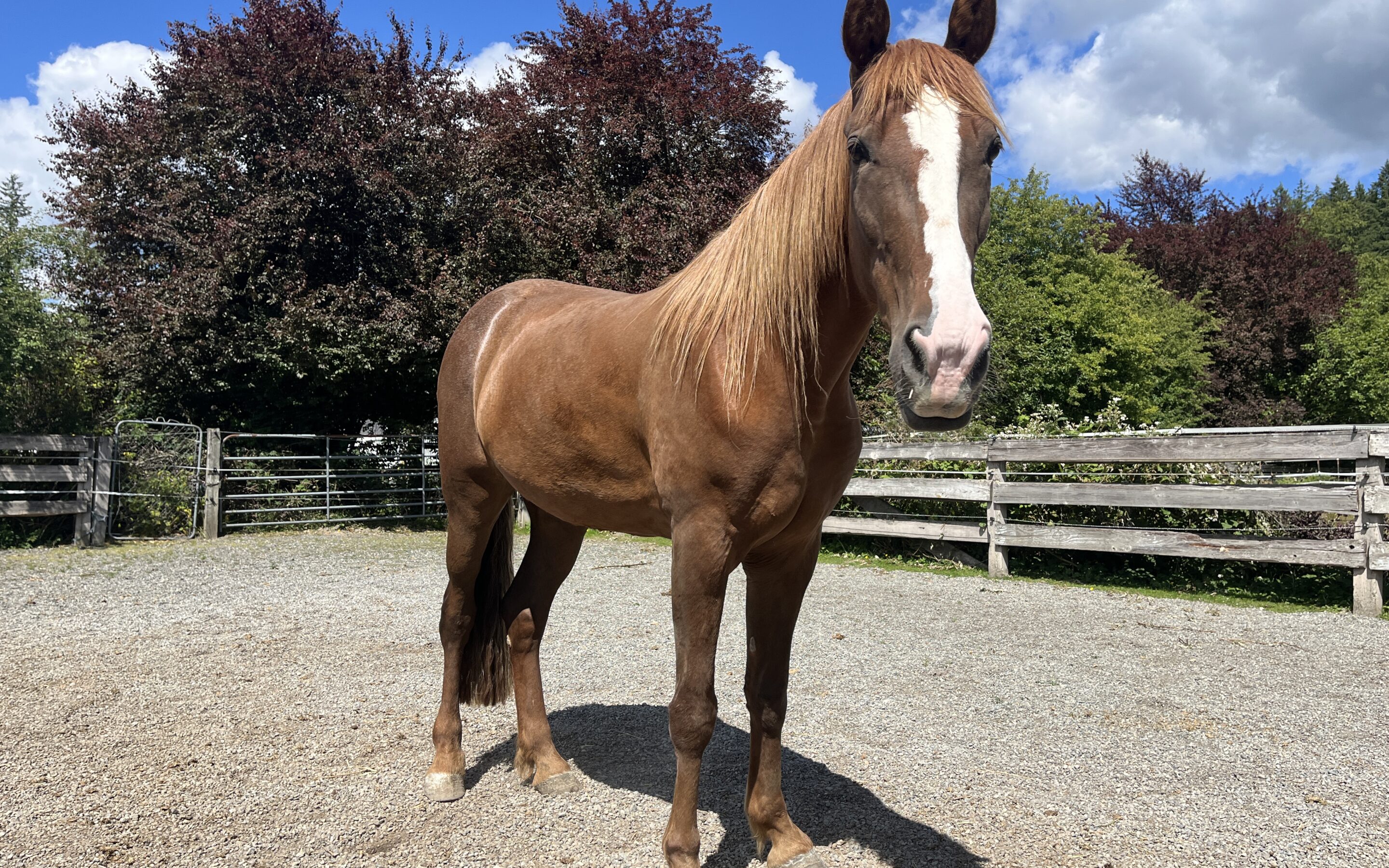
Halter-Starting the Halter-Started
We have no shortage of chestnut mares at SAFE. It’s our most popular color, in fact, with no fewer than 10 in our care currently. Deja Vu is aptly named, then, being a chestnut mare herself. Walking by her paddock, you may ask yourself, ‘have I seen this horse before?’ But after spending a bit of time with her, you’d come to the realization that she, like all the rest, is an individual, not to be referred to as ‘just another chestnut mare.’
Deja, as has become her moniker, is a wary, but intelligent gal. While she arrived able to be haltered and handled, one quickly came to the realization that she was doing so in spite of you, not because of you. So recently we have been working on getting her to hook on to a person instead of tuning them out, helping her be an active participant in what is happening versus merely allowing things to happen to her. This is demonstrated in something as simple as going in to catch her. Yes, she will allow you to walk up and put a halter on – if you approach with some caution and finesse – but it is clear from the way she looks towards her horse neighbor or the surrounding environment that she is not at all with you. If you are to raise the energy, she scrambles away, and tunes out your bids to restore a connection that wasn’t there to begin with. She does not yet find peace in humans, despite how she might have originally appeared by being halterable and ‘gentle.’
So each time we go to catch her now, instead of sneaking a catch on her, so to speak, we ask her to hook on to us. At this stage, this looks like a little bit of work. We send Deja around the paddock, sending energy towards her hip in order to encourage her to face us. Once she does, she gets a break as long as she is standing facing us with her attention also pointed in our direction. If that attention breaks or if she feels the need to move off, totally fine, but back to work she goes. The first time we did this, Deja felt the need to scramble around the paddock, changing direction on a whim, and feeling like she was only able to stop in a way where she could have eyes on her friend. But she is a smart mare, and was soon realizing that the answer we were looking for was one that involved looking for us. Soon, she was seeking out opportunities to find us, and by extension, the release.
It’s important to work both the right and left sides of a horse, and it is also fascinating to see how the two differ. Most horses are handled more on the left side (being the side they are haltered and led from in the majority of cases), and while you may think that this might be their ‘better’ side, the opposite can also be true. Sometimes, they have learned more negative habits or tendencies on the left due to poor handling, meaning that the right side is actually the side where they are softer and more pliable. But, it can also mean that they are more comfortable with people on that left side, so even if the right side is ‘better,’ they may want to keep you on the left eye where they are more used to seeing you. Deja is definitely less brace‑y on her right side, but does have a tendency to want to get you back on the left eye.
Each time we go to catch Deja in this new way, the time it takes for her to hook on grows shorter and shorter. She has even begun to take a few steps towards us when she draws in, showing that she is choosing the connection rather than having it foisted upon her.
Just because a horse has been haltered before does not mean it has been done with quality, and also does not mean that we will write them off as being ‘done already.’ We may have to work to undo what has already been done in Deja Vu’s halter starting, but helping to rebuild this foundation will have a massive impact on the quality of communication she is able to have with humans for the remainder of her life. Besides, we may have done this a time or two before – the real Deja Vu!

Walkin’ Into SAFE: Zuri, Bailey, Cleopatra, Deja Vu
Four new mares Tennessee walked into SAFE last week: Zuri, Bailey, Cleopatra, and Deja Vu.
Their story is one of neglect, as is so often the case with our new intakes, but as they were seized by out friends down at Pierce County Animal Control, they have been in very good hands since they were first rescued. The girls were all tremendously thin before they were taken, with body condition scores in the 1–3 range. Cleopatra, who was in the best shape (a relative term), had only held on to her little bit of extra weight by being food aggressive. No horse should have to fight for a meal.
For the last few months, they have been rehabbing down south, but last Friday made the trek up to SAFE. So far, everyone has been settling in well here, enjoying at least five meals a day, and getting to know the routine and the volunteers who already adore them.
Zuri and Bailey are the two matrons of the group, neither a stranger to being handled. Word is that they were show horses, once upon a time, and they do have a ‘been there, done that’ worldliness about them.
Zuri is likely 30, and was in some of the worst shape of them all. She has gained a significant amount of weight over the course of her time at foster, but there is still visible evidence of her pointiness. She has a history of colic, so we are keeping a close eye on her eating and bathroom habits (a standard across the new intake board, of course, but something that we are making sure to pay extra attention to given what we know). She is so far curious and friendly, and will greet you vocally — especially if you come with food.
Bailey is also 30 or above, and has a history of laminitis that has led to some significant rotation in her front feet, particularly her left. Bailey’s hooves were in terrible condition in general, so managing her overall comfort has been a high priority. She has been living in soft ride boots, and taking daily equioxx, both of which have been helping some. But she doesn’t let her feet stop her from being a sassy lady!
During her intake photoshoot, Bailey was quick to remind us that she would much rather be chowing down on her alfalfa, thanks very much. She is a hoot!
Cleopatra is 20, and as previously mentioned, looks the best out of the four. Despite her food aggressiveness with other horses however, she is rather shy around humans. While she does allow you to halter and touch her all over, she is clearly uncertain at times. It will be wonderful to see her come out of her shell a little once she settles in more here at SAFE.
Deja Vu, so named because of her physical similarity to Cleopatra, follows her doppleganger’s personality thru-line as well, being perhaps the most wary of the group. Still, she is not untouchable by any means, and allows for haltering and blanketing, but is definitely hyperaware of everything that is happening. Though we do not know if Cleo and Deja have riding backgrounds, signs point to ‘no.’
All four ladies are settling in well at SAFE, where they are growing used to the rhythms of this place. One thing is for sure, they already know the sound of the food truck!
Deja Vu’s Friends:
1. Julie S.
2. Jennifer B.
3. ____________________
4. ____________________
5. ____________________
6. ____________________
7. ____________________
8. ____________________
9. ____________________
10._____________________
Every horse deserves at least ten friends! Even a small monthly donation can make a difference.
Click here to sponsor Deja Vu!

